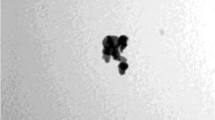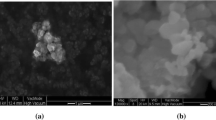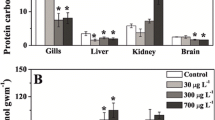Abstract
Accumulation of copper oxide nanoparticles (CuO NPs) in gill, liver and muscle tissues of Oreochromis niloticus and its effects on superoxide dismutase (SOD), catalase (CAT) and glutathione peroxidase (GPx) activities in gill and liver tissues were studied after exposing the fish to 20 µg/L Cu over 15 days. Copper levels and enzyme activities in tissues were determined using spectrophotometric (ICP-AES and UV) techniques respectively. No mortality was observed during the experiments. Copper levels increased in gill and liver tissues of O. niloticus compared to control when exposed to CuO NPs whereas exposure to metal had no effect on muscle level at the end of the exposure period. Highest accumulation of copper was observed in liver while no accumulation was detected in muscle tissue. SOD, CAT activities decreased and GPx activity increased in gill and liver tissues when exposed to CuO NPs.
Similar content being viewed by others
Explore related subjects
Discover the latest articles, news and stories from top researchers in related subjects.Avoid common mistakes on your manuscript.
Nanoparticles (NPs) are defined as particles with dimensions between 1 and 100 nm and have unique properties such as high surface area due to their small size (Gomes et al. 2011). Cu NPs are mainly used in electronic circuits, batteries, gas sensors and in wood preservation. Production and use of engineered nanomaterials likely result in their release into aquatic environments and can lead to unexpected hazards on aquatic organisms (Klaine et al. 2008).
Copper is a basic element for the continuation of a number of metabolic functions such as hemoglobin synthesis, bone formation and it forms the structural components of many enzymes (Nussey 1995). Exposure to this metal over certain concentrations, however, result in tissue accumulation and may alter various physiological functions (Nussey 1995).
The toxicity of copper ions to aquatic organisms is well known and as a redox metal Cu participates in Fenton and Haber–Weiss reactions, facilitating the formation of reactive oxygen species (ROS) and oxidative stress (Bebianno et al. 2004). The cellular defense system against toxicity from ROS includes superoxide dismutase (SOD), catalase (CAT) and glutathion peroxidases (GPx). SOD is a group of metalloenzymes that catalyse the conversion of reactive superoxide anions (O2 ·−) to yield hydrogen peroxide (H2O2), which is subsequently detoxified by CAT or glutathione peroxidase (GPx) (Unfried et al. 2007). CAT is hematin-containing enzymes that facilitate the removal of hydrogen peroxide (H2O2), which is metabolized to molecular oxygen (O2) and water (Unfried et al. 2007). GPx catalyses the metabolism of H2O2 to water, involving a concomitant oxidation of reduced GSH to its oxidized form (GSSG) (Lesser 2006).
Oreochromis niloticus is a tropical freshwater fish and cultured extensively for its economic importance. Moreover O. niloticus have high tolerance to changing environmental conditions, such as temperature and salinity, have a short food-chain, good food valuation rate and are resistant to parasitic diseases and intensive stocking conditions (Khallaf et al. 1998).
Exposure to heavy metals may result in tissue accumulation and can cause oxidative stress. Hence the aim of the present study was to determine accumulation of copper in gill, liver and muscle tissues of O. niloticus and its effect on superoxide dismutase (SOD), catalase (CAT) and glutathione peroxidase (GPx) activities in gill and liver tissues after exposing the fish to 20 μg/L CuO NPs over 15 days.
Materials and Methods
Commercially available CuO nanopowder, (Sigma-Aldrich; particle size <50 nm) was used in the preparation of experimental solutions. Solutions were replaced daily by serial dilutions of freshly prepared 100 ppm stock solution of the metal. Before each renewal CuO solution was sonicated for 30 min (Ultrasonic bath 230 V, 200 W, 45 kHz frequency) before each renewal to break down the size of aggregates.
CuO NP suspensions prepared were dispersed in both Milli-Q water (18 MΩ/cm) and tap water at concentrations of 100 mg/L. The resulting suspensions were sonicated for 15 min using a bath sonicator (USC500TH, VWR International) immediately prior to analysis. Samples were then analyzed for NP size (z-average hydrodynamic diameter) and surface charge (zeta potential) (Fig. 1). CuO NPs were also characterized by X-Ray diffraction (XRD). More details on the characterization methods are described in Gomes et al. (2011) (Table 1).
Oreochromis niloticus was obtained from the rearing pools of Fisheries Faculty, Cukurova University, Adana, Turkey. The mean length and weight of fish were 21.9 ± 1.7 cm and 148 ± 5.11 g respectively. Fish were adapted to laboratory conditions for 1 month in glass aquaria 40 × 120 × 40 cm in height. Experiments were run in triplicate being three fish in each replicate. The same sized two aquaria were used in the experiments; hence nine fish were placed into each aquarium. Exposure to fish to 20 µgCu/L which is two times of environmentally realistic concentration (Bebianno et al. 2004; Bryan and Langston 1992). The first aquarium was filled with 120 L 20 µgCu/L solution whereas the second one was filled with the same amount of copper free tap water and used as control. Mean copper levels in exposure media were determined as 19.95 ± 0.05 µg/L Cu. Experimental solution were replaced daily, by serial dilution of freshly prepared 100 ppm stock solution of the metal. Some physical and chemical properties of experimental water are given in Table 2.
Fish were fed once a day with readymade fish feed (Pınar, Pellet No: 2) at amounts of 2% of total biomass. Three fish were removed from each aquarium at the end of exposure period and were anesthetized with MS222. They were washed, dried and dissected for their gill, liver and muscle tissues.
Dissected gill, liver and muscle tissues were transferred to petri dishes and were placed in a drying oven set at 150 °C for 48 h. Dried tissues were weighted and transferred to experimental tubes and digested in nitric acid (Merck, 65%)/perchloric acid (Merck, 60%) mixture (2/1; v/v) at 120 °C for 3 h (Muramoto 1983). Digested tissues were transferred to polyethylene tubes and their volumes were made up to 10 ml with ultra-pure water. Metal levels in tissues were determined using a Perkin Elmer Optima 7000 DV Optical Emission Spectrophotometer. Quality assurance was checked using a standard reference material (lobster hepatopancreas) provided by the National Research Council, Canada-TORT II. Results were within the limits of 106.0 ± 10.0 µg Cu/g d w certified value.
Gill and liver tissues were homogenized in five volumes of Tris–HCl buffer (20 mM, pH 7.6) in an ice bath for 2 min to determine SOD, CAT and GPx enzyme activities. The homogenate was centrifuged at 500×g for 15 min at 4 °C to precipitate large particles. The supernatant was separated from the pellet and centrifuged at 12,000×g for 45 min at 4 °C to precipitate the mitochondrial fraction. The cytosolic fraction was then purified on a Sephadex G-25 gel column (PD10, Pharmacia). Bradford (1976) was adopted to determine total protein content. SOD, CAT and GPx activities were determined according to McCord and Fridovich (1969), Greenwald (1985) and Lawrence and Burk (1976) respectively.
Statistical evaluation of the experimental data was carried out using Student t test.
Results and Discussion
There was no mortality in O. niloticus exposed to 20 µg/L Cu NPs over 15 days. Gills are target organs in accumulating metals since they are in direct contact with the external media (Heath 1995). In Danio rerio exposed to 0.25–1.5 mg/L Cu NPs for 48 h, gills were the primary target organ for this metal (Griffitt et al. 2007). Significant increases were observed in accumulation of copper in gills of Oncorhynchus mykiss exposed to 20 and 100 µg/L Cu NPs compared to control levels, accumulation being five times higher in 100 µg/L Cu then in 20 µg/L. (Shaw et al. 2012). Copper accumulation also increased statistically in gill tissue of O. niloticus compared to control when exposed to 20 µg/L Cu NPs for 15 days (Fig. 2; p < 0.05).
Metals entering from gills are firstly transferred to liver by circulatory system and when the carrying capacity of liver is exceeded, they are transferred and stored in metabolically active tissues such as liver and kidney (Heath 1995). Muscle accumulation of metals is generally low compared with the liver and gill tissues which was also shown to be true in the present study. Differences among various tissues in accumulating metals is generally attributed to their metabolic activities (Cicik 2003; Tuncsoy and; Erdem 2014). Cicik (2003) reported liver accumulation of Cu was higher compared to gill and muscle tissues in C. carpio. Wang et al. (2014) reported that accumulation of copper in Epinephelus coioides exposed to 20 and 100 µg Cu NPs/L over 25 days was higher in liver than in gill tissue. Copper accumulation also increased statistically in liver tissue of O. niloticus compared to control when exposed to 20 µg/L Cu NPs for 15 days (Fig. 2; p < 0.05). Accumulation of copper was higher in liver followed by gill and muscle tissues of O. niloticus. Exposure to Cu NPs had no effect on Cu accumulation in muscle tissue of O. niloticus. These differences among the tissues in accumulating metals can be explained by variances in metabolic activities of these tissues. Although not an effective tissue in accumulation of metals muscle plays an effective role in carrying the metals to upper trophic levels hence it is important to monitor the levels of this metal in the environment as far as the human health is concerned.
Abdel-Khalek et al. (2015) reported SOD and CAT activities decreased in liver tissues whereas GPx activity increased in gill and liver tissues of O. niloticus when exposed to 7.5 mg/L CuO NPs for 30 days. Gomes et al. (2012) reported that SOD and CAT activities decreased whereas GPx activity increased compared to control after 15 days of exposure to 10 µg/L CuO NPs. SOD and CAT activities decreased in gill and liver tissues of Terapon jarbua when exposed to 1, 2.5 and 5 mg/L Cu for 96 h (Vijayavel et al. 2006). Wang et al. (2016) reported SOD and CAT activities significantly decreased in gill and liver tissue of Epinephelus coioides when exposed to 2.4 mg/L Cu NPs for 24 h. SOD and CAT activities were significantly inhibited in liver tissue of fish in Carassius auratus when exposed to 160 and 320 mg/L CuO nanoparticles for 4 days (Xia et al. 2013). SOD, CAT activities decreased (26% and 48% in gill; 29% and 8% in liver, respectively) whereas GPx activity increased (21% in gill; 5% in liver) compared to control after 15 days of exposure to 20 µg/L Cu NPs in O. niloticus (Figs 3 and 4). This might be because of excessive usage of CAT and SOD at the beginning of exposure and as their levels drop increase in GPx activity occurs for further protection against hydroperoxides.
The aim of the present study was to determine accumulation of copper in gill, liver and muscle tissues of O. niloticus and its effect on SOD, CAT and GPx activities in gill and liver tissues after exposing the fish. It was concluded that CuO NPs result in tissue accumulation and can cause oxidative stress which may lead to alteration of the antioxidant capacity of cells against ROS generation by either stimulating or decreasing enzymatic activities in O. niloticus.
References
Abdel-Khalek AA, Kadry MAM, Badran SR, Marie MS (2015) Comparative toxicity of copper oxide bulk and nano particles in Nile tilapia; Oreochromis niloticus: biochemical and oxidative stress. J Basic Appl Biol 72:43–57
Bebianno MJ, Géret F, Hoarau P, Serafim MA, Coelho MR, Gnassia-Barelli M, Roméo M (2004) Biomarkers in Ruditapes decussatus: a potential bioindicator species. Biomarkers 9(4–5):305–330
Bradford M (1976) A rapid and sensitive method for the quantitation of microgram quantities of protein utilizing the principle of protein-dye binding. Anal Biochem 72:248–254
Bryan GW, Langston WJ (1992) Bioavailability, accumulation and effects of heavy metals in sediments with special reference to United Kingdom estuaries: a review. Environ Pollut 76:89–131
Cicik B (2003) Bakır-çinko etkileşiminin sazan (Cyprinus carpio)’ın karaciğer, solungaç ve kas dokularındaki metal birikimi üzerine etkileri. Ekoloji 12(48):32–36
Gomes T, Pinheiro JP, Cancio I, Pereira CG, Cardoso C, Bebianno MJ (2011) Effects of copper nanoparticles exposure in the mussel Mytilus galloprovincialis. Environ Sci Technol 45(21):9356–9362
Gomes T, Pereira CG, Cardoso C, Pinheiro JP, Cancio I, Bebianno MJ (2012) Accumulation and toxicity of copper oxide nanoparticles in the digestive gland of Mytilus galloprovincialis. Aquat Toxicol 118–119:72–79
Greenwald RA (1985) Handbook of methods for oxygen radical research. CRC Press, Boca Raton
Griffitt RJ, Weil R, Hyndman KA, Denslow ND, Powers K, Taylor D, Barber SD (2007) Exposure to copper nanoparticles causes gill injury and acute lethality in zebrafish (Danio rerio). Environ Sci Technol 41:8178–8186
Heath AG (1995) Water pollution and fish physiology. CRC press, Boca Raton
Khallaf EA, Galal M, Authman M (1998) Assessment of heavy metals pollution and their effects on Oreochromis niloticus in aquatic drainage canals. J Egypt Ger Soc Zool 26(B):39–74
Klaine SJ, Alvarez PJJ, Batley GE, Fernandes TF, Handy RD, Lyon DY, Mahendra S, McLaughlin M, Lead JR (2008) Nanomaterials in the environment: behavior, fate, bioavailability and effects. Environ Toxicol Chem 27(9):1825–1851
Lawrence RA, Burk RF (1976) Glutathione peroxidase activity in selenium-deficient rat liver. Biochem Biophys Res Commun 71:952–958
Lesser MP (2006) Oxidative stress in marine environments: Biochemistry and physiology ecology. Annu Rev Physiol 68:253–278
McCord JM, Fridovich I (1969) Superoxide dismutase: an enzymatic function for erythrocuprein (hemocuprein). J Biol Chem 244(22):6049–6055
Muramoto S (1983) Elimination of copper from Cu contaminated fish by long- term exposure to EDTA and freshwater. J Environ Sci Health 18(3):455–461
Nussey G, Van Vuren JHJ, Du Preez HH, (1995) Effect of copper on the hematology and osmoregulation of the Mozambique tilapia, Oreochromis mossambicus (Cichlidae). Comp Biochem Physiol 111C(3):369–380
Shaw BJ, Al-Bairuty G, Handy RD (2012) Effects of waterborne copper nanoparticles and copper sulphate on rainbow trout, (Oncorhynchus mykiss): Physiology and accumulation. Aquat Toxicol 116–117:90–101
Tunçsoy M, Erdem C (2014) Accumulation of copper, zinc and cadmium in liver, gill and muscle tissues of Oreochromis niloticus exposed to these metals separately and in mixture. Fresen Environ Bull 23(5):1143–1149
Unfried K, Albrecht C, Klotz L, Mikecz AV, Grether-Beck S, Schins RPF (2007) Cellular responses to nanoparticles: target structures and mechanisms. Nanotoxicology 1(1):52–71
Vıjayavel K, Gopalakrishnan S, Thilagram H, Balasubramanıan MP, (2006) Dietary ascorbic acid and a-tocopherol mitigates oxidative stres ınduced by copper in the thornfish Terapon jarbua. Sci Tot Environ 372:157–163
Wang T, Long X, Cheng Y, Liu Z, Yan S (2014) The potential toxicity of copper nanoparticles and copper sulphate on juvenile Epinephelus coioides. Aquat Toxicol 152:96–104
Wang T, Chen X, Long X, Liu Z, Yan S (2016) Copper nanoparticles and copper sulphate induced cytotoxicity in hepatocyte primary cultures of Epinephelus coioides. PLoS ONE 11(2):1–15
Xia J, Zhou HZ, Guang Hua LU (2013) Effects of selected metal oxide nanoparticles on multiple biomarkers in Carassius auratus. Biomed Environ Sci 26(9):742–749
Acknowledgements
This work was supported by Çukurova University, Scientific Research Projects Coordination Unit. We would like to acknowledge Prof.Dr. Maria João Bebianno, Asst.Prof.Dr. Margarida Ribau Teixeira, Dr. Tânia Gomes and Vânia Sousa.
Author information
Authors and Affiliations
Corresponding author
Rights and permissions
About this article
Cite this article
Tunçsoy, M., Duran, S., Ay, Ö. et al. Effects of Copper Oxide Nanoparticles on Antioxidant Enzyme Activities and on Tissue Accumulation of Oreochromis niloticus . Bull Environ Contam Toxicol 99, 360–364 (2017). https://doi.org/10.1007/s00128-017-2129-z
Received:
Accepted:
Published:
Issue Date:
DOI: https://doi.org/10.1007/s00128-017-2129-z








